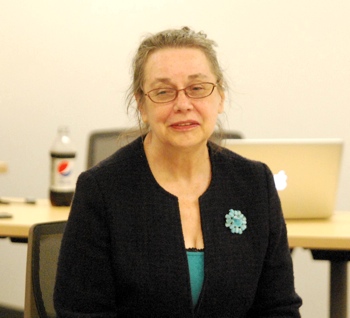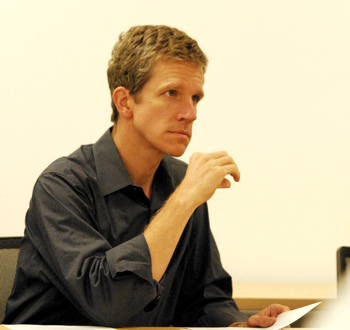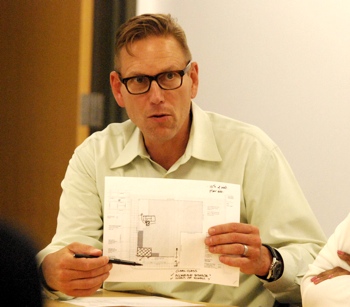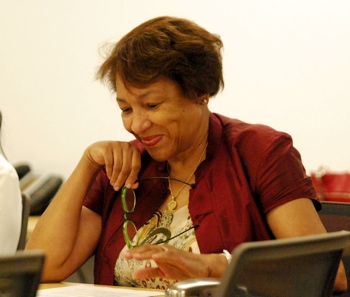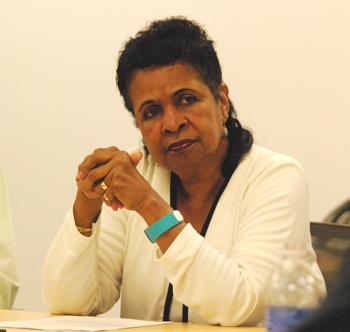New Citizen Participation Tools Reviewed
Ann Arbor planning commission working session (Aug. 12, 2014): Planning commissioners gave feedback on new guides that staff have developed for residents and developers, aimed at improving communication about proposed development projects.
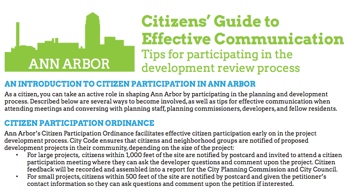
Excerpt from a draft guide being developed by the city’s planning staff. It was reviewed at the planning commission’s Aug. 12 working session.
The “Citizens’ Guide to Effective Communication” and “Developers’ Guide to Leading Effective Citizen Participation Meetings” were drafted by planning staff, based in part on suggestions from the planning commission’s citizen outreach committee.
Two other outreach documents were reviewed at the Aug. 12 working session – a guide to the city’s site plan review process, and a template for postcard notifications of citizen participation meetings.
In addition to giving feedback on those draft documents and how they might be distributed, commissioners discussed how to improve the effectiveness of mandatory citizen participation meetings and the reports that developers must provide based on those meetings.
The citizen participation meetings are held for all major projects, a requirement that’s been in place since the city council enacted a citizen participation ordinance in 2008. An evaluation of that ordinance was supposed to have been done five years ago. However, there had been a lull in development soon after the ordinance was passed. Planning manager Wendy Rampson told commissioners that now there have been a sufficient number of projects to evaluate, and to possibly make some thoughtful changes to the code.
Citizen Participation
The city’s citizen participation ordinance was approved by the city council on Sept. 8, 2008 and took effect Jan. 1, 2009. [.pdf file of citizen participation ordinance] It was an ordinance that Sabra Briere (Ward 1) advocated for after her election to the city council in 2007. Briere, Joan Lowenstein – who served on the council and planning commission at that time – and planning commissioner Kirk Westphal worked with city staff to develop the ordinance. Briere now serves as the council’s representative on the planning commission.
Among other things, the ordinance requires the owner or developer of a project to hold a citizen participation meeting before a project is formally submitted to the city for approval – specifically, for planned projects, planned unit developments, rezonings, and major site plans. Developers are expected to:
… pursue early and effective citizen participation in conjunction with their proposed developments, giving citizens an early opportunity to learn about, understand and comment upon proposals, and providing an opportunity for citizens to be involved in the development of their neighborhood and community;
The ordinance also requires that written notification of the citizen participation meeting be sent to property owners, residents and registered neighborhood groups within 1,000 feet of the project site. The developer must then submit a report to the city that describes any issues raised by citizens and how the project will address those issues.
No formal evaluation of the ordinance has been completed, though that was initially expected to take place a year after it was enacted. An evaluation is part of the planning commission and staff’s 2014-2015 work plan, with a target completion of January 2015. Planning staff and the commission’s citizen outreach committee will be working on that. Committee assignments for the current fiscal year have not yet been made.

Katy Ryan, an intern with the city’s planning unit. Her last day with the city was Aug. 15. She’s been accepted into the Ph.D. program at Rutgers University to study human geography. She told commissioners that she’s interested in climate change issues in rural neighborhoods, and how public participation can be used to encourage engagement.
The citizen outreach committee met most recently in January 2014, and had made some recommendations for improving engagement. Members of that committee were Sabra Briere, Diane Giannola, Jeremy Peters and Paras Parekh. Parekh recently resigned from the planning commission, as he made a job-related move out of town.
Based on the committee’s direction, staff had drafted some new materials that were brought to commissioners for review at their Aug. 12 working session.
Katy Ryan, an intern with the planning unit, gave a presentation on those materials that she had helped develop: (1) a citizens’ guide to effective communication; (2) a developers’ guide to leading effective citizen participation meetings; (3) a guide to the city’s site plan review process; and (4) a template for postcard notifications of citizen participation meetings.
The one-page citizens’ guide outlines elements of the citizen participation ordinance, describes ways that residents can get involved, and gives tips on how to effectively provide input. [.pdf of citizens' guide]
The developers’ guide, also a one-page document, gives direction about how best to handle the mandatory citizen participation meeting. [.pdf of developers' guide] Also for developers, a guide to the city’s site plan process describes the steps involved in this review, as well as an estimated timeline for each phase. Residents could also use this guide to see what the city requires and when there’s an opportunity for input, Ryan said. [.pdf of site plan guide]
The template for postcard notices is an effort to standardize communication so that the same information is always provided. [.pdf of postcard template]
Ryan also highlighted the new citizen participation site that launched earlier this summer, as part of the city’s overhaul of its entire website. Some outdated items were removed, and new information is intended to help people find what they need, she said. The new guides for citizens and developers are posted there. Google analytics indicate a spike in usage, she reported, and the bounce rate has improved – it’s been lowered by 8%.
Citizen Participation: Commission Discussion – Materials
Jeremy Peters asked how these guides would be distributed, other than the website. Katy Ryan replied that when developers meet with staff, they can be made aware of these guides. The citizens’ guide could be distributed to neighborhood groups, she said.
Planning manager Wendy Rampson reported that one of this year’s goals for the planning unit is to reach out to neighborhood associations. Part of that is to update the current information that the planning staff maintains, but another aspect is to create a stronger connection between the planning staff and residents.
Peters suggested including a link to the citizens’ guide, as part of the notification of a project in its early stages.
Rampson indicated that Ryan didn’t have time to revamp the city’s public hearing notices, but that’s next on the list. Those notices have to contain certain types of information, since they are legal notices, “but we could certainly make the wording more friendly” and include short URLs, she said.
Regarding the estimated project timeline that’s outlined in the site plan guide, Ken Clein suggested adding a disclaimer – that there’s no guarantee the timeline will follow those estimates.
Sabra Briere asked if printed handouts would be available for these guides. She noted that some residents would want the information, but they’re not necessarily computer savvy. Rampson replied that the staff have stopped keeping printed handouts in stock, but if someone comes to the front desk at city hall, it could be printed for them. She added that there could be printed handouts available at the planning commission meetings, as an option.
Wendy Woods wondered if the city ever sends out this kind of information with its water bills or other mailings. Rampson said the city mails out the Waste Watcher publication, which primarily includes public services-related information. But the city has also used inserts in its water bills at times, she noted. Those bills go out quarterly. She thought it probably wouldn’t entail additional cost to the planning unit’s budget, but would be handled by the communications staff.
However, more people are choosing to pay their water bills online, Rampson said, so that kind of mailing wouldn’t reach everyone.
Kirk Westphal liked the bullet point in the citizens guide that emphasized working with neighborhood associations, and he wondered if that could be stressed even more – especially for communications that happen before a developer actually submits a formal proposal.
Diane Giannola expressed caution about that. “The problem with neighborhood associations is that they’re controlled by a certain group of people – and that’s not necessarily the views of the entire neighborhood,” she said. For her own condo association, “the president runs everything.”
Westphal thought that if a neighborhood association meets with a developer over a proposed project, “it’s a great time for that neighborhood to hear from each other – it’s sort of a forced collaboration, in a way.” Peters added that ideally, such a meeting would take place early enough in the process so that the developer could incorporate neighborhood feedback.
Responding to a query from commissioners, Ryan said the design that’s featured in the citizens’ and developers’ guides was made by taking a photo of Ann Arbor’s skyline, tracing it in Photoshop, and filling in the outline with solid green.
Citizen Participation: Commission Discussion – Mandatory Meetings
Commissioners also discussed the format of the mandatory citizen participation meetings. Rampson said that some residents have told planning staff that Brad Moore – a local architect who’s involved with several projects in Ann Arbor – handles those meetings particularly well. So the planning staff plans to interview him for tips he might have that could be passed along to other developers.
Briere reported that she and Peters had just attended part of a citizen participation meeting, which started a half hour before the working session – Moore had been leading that one, too. [That participation meeting was held from 6:30-8 p.m. on Aug. 12 at the DDA offices, about a block from city hall. It focused on a project proposal to rezone 221 Felch St. and adjacent parcels from M1 (limited industrial district) to R4D (multiple-family dwelling district) to allow for a low-rise residential development over enclosed parking.]
Moore presented solid information, Briere said, and he reiterated that the current step is for rezoning – not for a building design and site plan. He started out with a description of the land, some conceptual ideas, and the rationale for their approach. “He was very good about knowing how people react,” she said.
Peters added that instead of starting with a vision for the building, Moore began by talking about the land’s topography within the Allen Creek watershed, flooding issues, and other challenges of the site. The landscape architect was also on hand to discuss these issues before showing a possible building footprint on the site.
Rampson noted that a good land planner does that kind of site analysis first, and starts putting layers on top of that to develop a project.
Briere pointed out that in contrast to Moore’s approach on the Felch Street project, the Toll Brothers representatives – at their July 10 citizen participation meeting for a 500-unit development at Nixon and Dhu Varren roads – led off by showing a site plan and pictures of the buildings. They didn’t start off by talking about how they’d handle issues that would affect neighbors, like landscape buffers, stormwater and traffic, she noted.
Eleanore Adenekan observed that neighbors go to those meetings to be heard, but they also come with their own pre-conceived notions about a project. Do the meetings include time for questions?
Briere explained that there’s no consistent format for the citizen participation meetings. There’s always an opportunity for Q&A, “whether it’s offered or taken,” she said, but it happens in different ways.
At the Toll Brothers presentation, because they tried to present so much information, they were constantly being interrupted, Briere said. In contrast, Moore and the Beal family – who own the Felch Street property – handled it in a more relaxed manner, so that it was more like a conversation.
Rampson pointed out that there’s a difference in the size of those two projects, which might have also been a factor.
Briere indicated that the responses to neighbor concerns at the Toll Brothers’ presentation were “not uniformly respectful, not understanding the impact on the existing properties.” In contrast, for the Felch Street proposal, Moore had offered to visit the neighbors and talk about their concerns. The difference might be that the Felch Street developer is local, Briere noted, and Toll Brothers isn’t.
“It’s a hard process to go through, engaging the public,” Briere said. “The more comfort you feel with it, the more often you do it, the better you get.”
Commissioners also talked about whether planning staff should attend the citizen participation meetings. Some people thought there might be a “chilling effect” if commissioners or staff attended, Westphal said, or if a city councilmember attended. If someone did attend, he didn’t think it was appropriate to speak – unless it was for clarifying a fact.
Briere, who serves on city council, said she attended the Toll Brothers meeting and spoke about “what the ordinance said, what the expectations were, who was responsible, and why there were no staff present.” The project is located in Ward 1, which she represents.
Giannola thought the issue was whether the public would want the planning commissioners to speak during a citizen participation meeting. “That’s their attempt to talk to a developer,” she noted. “We’re going to have our chance later, so we shouldn’t be there giving out opinions.”
Briere agreed that giving an opinion wouldn’t be appropriate, but answering questions was fine. Giannola ventured that sometimes opinions are conveyed when answering questions. “Maybe, maybe not,” Briere replied. “It depends on your self control.”
Some residents who attend these meetings might be concerned that a commissioner or councilmember would be defending or promoting a development, Briere said, but “many of them are simply looking for answers. They want to know what the rules are.”
If there isn’t someone knowledgeable in the room, she added, “it’s possible for the developer to simply be besieged.” At the Toll Brothers meeting, some residents were demanding answers to questions about traffic flow, for example, which Briere said “was completely outside of their capacity to answer.”
Giannola said that indicated that perhaps a staff member should attend. Briere pointed out that prior to the citizen participation ordinance, staff members used to attend any meeting held by a developer. “More than one member of the public saw the staff in the role of defending and promoting the development, which puts the staff member in a very delicate position,” she said.
That might be because people don’t like the answers that the staff provided, Giannola said. Westphal added: “The staff is defending the master plan and the zoning.”
Briere said she wasn’t advocating for staff not to attend. She herself attends these meetings, and thinks that she should continue do that. It’s important to have someone there who can stand up and say that the answer to a particular question is something that the city, not the developer, should address at a later date, Briere said.
Rampson said that one strategy would be for planning staff to coach a developer’s design team, letting them know it’s OK to defer questions that they can’t answer. The answers could then be included in the citizen participation report, and sent to residents, she said.
Rampson noted that although materials have been developed and the planning unit’s website is redesigned, there are other issues to address – including possible changes to citizen participation meetings. She suggested pulling the outreach committee together to talk about next steps.
Citizen Participation: Commission Discussion – Mandatory Reports
Briere encouraged the planning staff to think about how the citizen participation reports might be given to planning commissioners in a more timely way. Right now, the ordinance doesn’t require that reports come to the planning commission. The reports are included in the commission’s meeting packet when a project is reviewed.
Rampson clarified that Briere also wanted the reports to follow a template, so that there would be consistency. Right now, Briere said, it’s difficult for planning commissioners to use the report as they evaluate a project.
Wendy Woods noted that some concerns had been raised that the report of a citizen participation meeting is biased, because it’s prepared by the developer – so the developer naturally wants to make it look as good as possible for the project.
Briere pointed out that the ordinance requires a developer to send the citizen participation meeting report to everyone who attends – assuming that they’ve provided contact information. So there’s a way for attendees to give feedback on the report. Rampson said the planning staff hasn’t been following up to make sure that’s happening, but they can start including that check as part of the process.
Giannola noted that one developer had included email exchanges with residents, as part of his citizen participation report. That had been very helpful, she said, because it included questions from neighbors as well as the developer’s responses.
Ken Clein thought developers would actually appreciate having a simple template to follow as they compile their report. “It’s sort of like Citizen Participation for Dummies,” he quipped. Westphal replied: “Let’s not make that the title.”
Westphal suggested that planning staff touch base with other communities that have had a citizen participation ordinance in place longer than Ann Arbor – like Auburn Hills.
Briere noted that for many residents in Ann Arbor, the citizen participation process “is an opportunity to try to discourage development. That isn’t the case in every community.”
Rampson reported that some communities go to great lengths to try to publicize development proposals. One community in Colorado had hired someone to create a website that listed all the projects and provided regular updates. Ann Arbor does that through its eTRAKIT system, she noted, “but you have to dig.”
Briere said she’d never gotten eTRAKIT to work for her. “I’m pretty savvy, and if I can’t get it to work for me, there’s a lot of other people who don’t even try after the first time,” she said.
Ryan gave an example from Philadelphia, which has developed a quick reference guide to zoning. It would take time to develop something similar for Ann Arbor, she said, but it would be a great resource.
Rampson suggested that this is an issue the subcommittee can discuss further, and then bring recommendations to the full commission.
Citizen Participation: Commission Discussion – Ordinance Evaluation
An evaluation of the citizen participation ordinance was supposed to have been done five years ago, Rampson said, “but we’re working on it.” There had been a lull in development soon after the ordinance was passed, but now there have been enough examples to evaluate it and possibly make some thoughtful changes to the code, she noted.
Citizen Participation: Public Commentary
Former planning commissioner Ethel Potts attended the working session and spoke during the final opportunity for public commentary. Potts had served on the planning commission when the citizen participation ordinance was developed and implemented.
She said she used the city’s website primarily to find meeting schedules and agendas, but she’s having difficulty navigating the site after the recent redesign. She also hoped that the site could include all meetings, such as committee meetings. “I struggle to find out when many of these meetings are,” she said, “and I miss some that I really wanted to go to.”
Regarding the city’s list of neighborhood associations, Potts reported that some of the information is outdated. Some of the contact people who are listed have moved out of town, for example, or died.
Regarding citizen participation meetings, Potts said that a good approach is to present very general information at first, then drill down with more details as questions are asked. That way, the information is tailored to the interests of the people who are attending, she said.
Potts said she’s attended some citizen participation meetings that were “dreadful – about as bad as you could get.” The developers either took too much or too little time presenting their proposal, she said, and didn’t know how to deal with the public. In one case, there was a resident who monopolized the whole meeting, she said. “So it can go badly – mostly it doesn’t, but it can.”
Present: Eleanore Adenekan, Sabra Briere, Ken Clein, Diane Giannola, Kirk Westphal, Wendy Woods, Jeremy Peters. Also: City planning manager Wendy Rampson.
Absent: Bonnie Bona.






